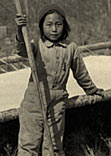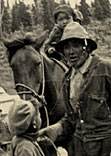Yukon First Nations
The Alaska Highway is a commonly cited cause of changes which began to take place in First Nations communities after 1942. Decline in fur prices and the introduction of family allowance were also factors; however, many First Nations elders define "the highway" as the primary catalyst for the breakdown of traditional ways. The First Nations’ existence, centred on a close relationship with the land, had been interrupted during the nineteenth and twentieth centuries by the fur trade and the gold rush. However, the highway’s effect was lasting as it altered the native-white population balance, and put First Nations people in the minority in the Territory. Also, diseases and wage work altered the First Nations relationship with the land and with each other, making them less self-sufficient and more dependent on government.
After a successful hunt... (view more details)
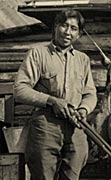
George Blondin and Little Edward Blondin, Sheldon Lake, 1943... were hired by Guy Blanchet to find a route for the Canol Pipeline from Norman Wells over the Macmillan Pass to Ross River. (view more details)
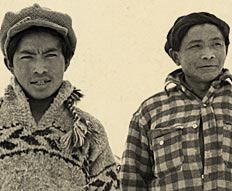
With the Alaska Highway came the promise of wage work, which lured many First Nations members away from the traditional economy of hunting and trapping. When the Army surveyed the Alaska Highway and Canol road routes, they hired many First Nations men as guides in the Yukon, British Columbia and Northwest Territories wilderness. These men often provided horses or sled dogs for transportation as well as their intimate knowledge of the land. Wage work on the highway attracted even more First Nations members after 1944 when fur prices started to decline.
A First Nations family enjoys a picnic by the fire with two cars in the background. 1937 (view more details)

Outsiders brought in diseases such as measles and meningitis which became epidemics in the small communities along the route, resulting in deaths in Teslin and Burwash. There were other serious social impacts as well, such as reports of theft by construction workers of objects from First Nation graveyards. The workers in the camps and in town brought alcohol to communities along the construction route, impacting the social behaviour of aboriginal people.
First Nations women scraping moose hide. ca. 1943. (view more details)
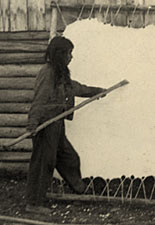
The coming of the automobile to the Yukon would change social patterns as it had in other parts of rural North America. The car made people more solitary, more mobile, and more interested in leaving sparsely-populated areas for larger centres. It had an especially strong effect on young people, taking them away from the old way of life and causing them to lose skills that had been passed down from previous generations.
Pelts and snowshoes are in abundance outside the cabin. Tagish, 1920s. (view more details)
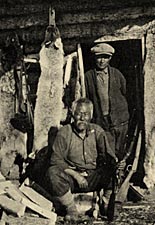
Not all the impacts of the Alaska Highway were negative. Improved communications and transportation helped First Nations people organize themselves politically. This new political strength helped them regain authority over their lands. The highway improved the standard of living of many First Nations as road access to communities facilitated the improved delivery of services, such as medical care. The highway also provided an alternative way to ship goods into the territory, making them more readily available.

